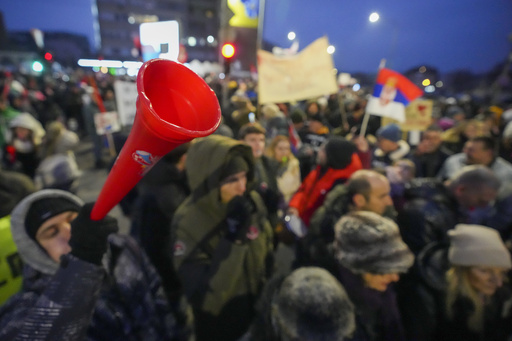The student protest is part of a broader anti-corruption movement gaining momentum across the country, spurred by a tragic incident in Novi Sad where a concrete canopy collapsed on November 1, claiming 15 lives.
Hundreds of thousands gathered in Kragujevac, reflecting the city’s historical significance from when it declared a new constitution in 1835 under Ottoman rule, a moment now commemorated as Statehood Day. Protesters not only called for accountability over the tragedy but also urged officials to tackle corruption and uphold the rule of law.
As attendees streamed in from all corners of Serbia, many voiced their support for the student-led movement. A Belgrade resident, identified as Teodora, expressed her hope for justice and a dignified life in the nation, stating, “I am here to support this student rebellion, which has grown into a civil rebellion.”
The students, greeted with enthusiasm by local residents, organized marches from various regions to the protest site, where supporters offered food and lodging, fostering a sense of community and shared hope for change.
In contrast, President Vucic held a rally in the town of Sremska Mitrovica, where he discussed nationalist sentiments, alleging that Western powers aimed to forcibly remove him, which he claimed could lead to the fragmentation of Serbia. He labeled the student protests as “the dirtiest color revolution in the history of mankind,” drawing parallels to past uprisings in Eastern Europe.
During his speech, Vucic asserted that over 3 billion euros were secretly funneled from abroad to undermine his administration, though he provided no evidence to support such claims. He suggested that the student movement wasn’t gaining traction, stating, “They have already lost, they don’t see how the political wheel has already turned,” a comment linked to the American political landscape and his support for Donald Trump.
Vucic vowed to document his efforts to quell the student protests in a forthcoming book, which he claimed would be published internationally, including in China. Meanwhile, authorities reportedly transported numerous Vucic supporters to his rally, bolstering his crowd sizes.
The anti-corruption movement presents a significant challenge to Vucic, who has maintained a tight grip on power during his decade-long reign. Critics allege that his administration suppresses democratic rights and manipulates election processes. The canopy disaster is widely seen as a symbol of broader dissatisfaction with authoritarian governance, with students rising as key figures in the protest movement.
Legal repercussions have ensued, as 13 individuals have been charged following the incident, and protests led to the resignation of the country’s prime minister. However, student activists remain unwavering, insisting that demonstrations will continue until their demands for accountability are fully realized.
In recent months, Vucic has swayed between accusing protesters of foreign allegiance and claiming to fulfill their requests. Earlier this week, during his visit to Bosnia’s Serb-controlled area, he reiterated the importance of Serbian unity, reminiscing about the historical context of Serbian efforts to establish a pan-Serb state, which previously incited conflict in the 1990s, resulting in extensive casualties and displacement.
At the rally, Milorad Dodik, a leader of Bosnian Serb separatists, voiced sentiments about uniting Serbs in Bosnia with Serbia, receiving enthusiastic approval from attendees, who echoed their affinity for Serbia.




